What is the point zone defense in basketball
The point zone defense is a basketball defensive strategy that primarily seeks to prevent dribble penetration, hinder low post touches, and influence contested jump shots to ultimately disrupt offensive scoring opportunities near the basket or near the perimeter areas of the court.
In addition to that, the point zone defense was also used by Coach Dean Smith during his time as the head coach of the University of North Carolina men’s basketball team.
What is an example of the initial formation of the point zone defense
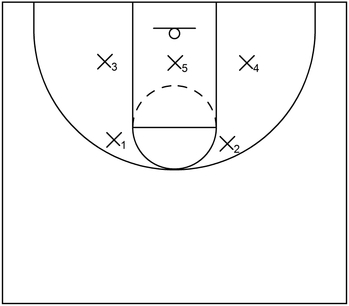
This is an example of the initial formation for the point zone defense. X1 starts near the left side high post elbow while X2 begins near the right side high post elbow.
X3 and X4 begin near the left side and right side extended low post blocks respectively while X5 is initially in front of the basket.
Also, it should be noted that while this formation is similar to a 2-3 zone defense, the point zone defense itself does not operate with the exact mechanics as the 2-3 zone.
Instead, in the point zone defense, one defender executes on-ball pressure defense and at the same time, the other defenders are essentially executing zone defense.
What are the general roles of the defenders within the point zone defense
In terms of the general roles, X1 takes point with on-ball pressure or covers the high post area to primarily prevent dribble penetration towards the middle.
The complementary partner of X1, which is X4, could protect the basket, prevent baseline dribble penetration, or take point and implement on-ball pressure defense as well.
Similarly, X2 and their complementary partner X3, could take point with on-ball pressure defense or execute help defense, particularly on the weak side of the court.
Also, it should be mentioned that whenever a defender takes point, that same defender should communicate with the other teammates by saying something like “Point” or “I have point” to let the teammates know who is currently guarding the ball.
X5 is the center of the defense, both literally from the standpoint of a traditional basketball position and symbolically, in terms of being in between (or within the center) of the two pairs of defenders.
Furthermore, X5 is centered between the player with the ball and the rim itself as well.
The main focus of X5 is to primarily protect the basket and guard against any offensive player near the low post areas, if necessary, especially on the strong side of the court.
Additionally, X5 could temporarily cover the high post area in certain instances during offensive ball movement to discourage the high post entry pass or dribble penetration from the top.
When could the point zone defense be most useful
The point zone defense could be most useful when the offensive team prefers to score via their low post players and/or the offensive team in general does not shoot well near the perimeter areas, especially from three-point range.
What is a unique feature of the point zone defense
One unique feature of the point zone defense, particularly when compared to other basketball defensive strategies is that four defenders will work together in two pairs as complementary partners while the fifth defender will act as a defensive anchor located between both pairs.
Essentially, depending on the location of the basketball, one partner within a pair of defenders could take point and execute on-ball man to man defensive pressure.
Simultaneously, the complementary partner of that same pair, alongside the other pair of defenders, could cover a specific zone area of the court, hence the name of point zone defense.
As a more specific example, X1 will typically pair with X4 while X2 will usually pair with X3. At the same time, X5 is the defensive anchor between both pairs.
If X1 takes point and executes on-ball defense, then X4 would cover the lane near the basket, with zone defense principles.
Also, as that occurs, X2 and X3 would be the other pair of defenders and they would implement zone defense concepts as well.
Affiliate Disclosure: I may earn a commission on qualifying purchases made through the links below.
What are examples of defensive rotations within the point zone defense
Example 1
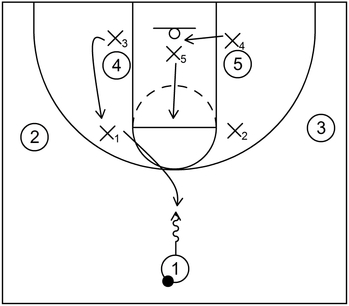
This is an example of the point zone defense when the ball is at the top. Furthermore, this example and the additional defensive rotations below are based on insights derived from Point Zone Defense by Dean Smith.
Initially, before implementing on-ball pressure or defensive rotations, each of the defenders should use high hands to discourage entry passes into the high post or towards the basket from the top.
Next, as 1 dribbles the ball closer to the three point line at the top, X1 calls point and steps up to implement defensive pressure.
As that occurs, X3 also lifts to fill the vacated space near the left side high post. This essentially means that if 2 were to receive the ball from 1, then X3 would be ready to execute a proper defensive closeout if necessary.
Furthermore, as the on-ball defensive pressure occurs, X5 could momentarily step up towards the bottom of the free throw line to further discourage a flash cut to the high post by any of the offensive players without the ball.
Moreover, X4 could temporarily slide into the lane to offer additional basket protection while X1 continues to implement defensive pressure against 1.
Example 2
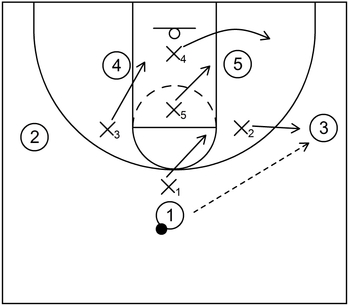
This is an example of defensive rotations within the point zone defense when the ball gets passed from the top to the wing. For this case, 3 receives the ball from 1 and when that occurs, X2 steps up to take point with on-ball pressure.
At the same time, X1 drops back towards the right side high post elbow to deter dribble penetration towards the middle while X5 drops back to guard against 5 near the right side low post block.
Also, X5 could utilize a low post front on the high side to hinder the post entry pass from 3.
Furthermore, X4 could slide out of the lane towards the right side short corner to limit baseline dribble penetration while X3 sinks into the lane near the weak side to take away the easy lob pass over the defense.
In addition to this, it should also be noted that if 3 decides to take the jump shot from that particular angle, then X1 could quickly sprint towards the left side high post elbow where X3 was originally located before sinking down.
From there, if 2 decides to go towards the rim for an offensive rebound, then X1 is there to execute a box out if necessary.
According to Coach Dean Smith, X1 would typically be able to gather a sizeable amount of rebounds during the game as well as throughout the season just by boxing out in that area.
Coach Smith basically implied that if the jump shot is missed on the right side, then the ball would usually take a long bounce towards the high or low post area on the left side of the court.
Example 3
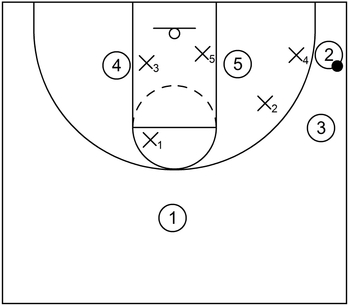
This is an example of the point zone defense in which 2 cut through to the right side corner and received the ball from 3.
When that occurs, X4 takes point and executes defensive pressure against 2. Also, X2 drops back into the gap between the wing and low post area on the right side.
By doing that, X2 is able to hinder dribble penetration towards the middle and X2 is also able to prevent the easy post entry pass to 5.
Additionally, X5 could execute a low post front, particularly on the baseline side as another tactic for discouraging the post entry pass.
X1 could stand near the left side high post to potentially get a defensive rebound if 2 or 3 were to take a jump shot while still being aware of 1 at the top.
X3 could provide extra basket protection and prevent weak side scoring opportunities while also boxing out 4 to limit offensive rebounds.
Example 4
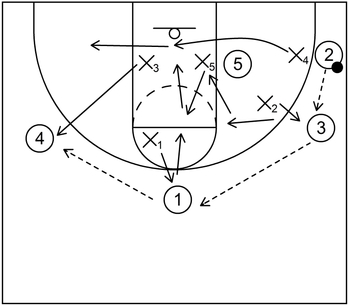
This is an example of defensive rotations within the point zone defense when ball reversal occurs from one side of the court to the other side.
To begin, 3 receives the ball from 2 and as that occurs, X2 takes point.
Following that, 1 receives the ball from 3 and as that happens, X1 takes point while X2 slides temporarily towards the right side high post elbow.
Also, X5 momentarily cuts just below the free throw line to take away a possible flash cut to the high post while X4 slides into the lane to protect the basket.
Next, 4 receives the ball from 1 to complete the reversal action from one side to the other.
Furthermore, as that happens, X3 executes a defensive closeout and takes point while X2 sinks down in the lane near the right side low post area.
In addition to that, X4 cuts across the lane to take away potential baseline dribble penetration by filling the left side short corner.
Moreover, in this instance, X5 can drop back in front of the basket because there is currently not a low post offensive player on the strong side of the court.
Also, X1 drops back to take away middle dribble penetration near the nail area.
Example 5
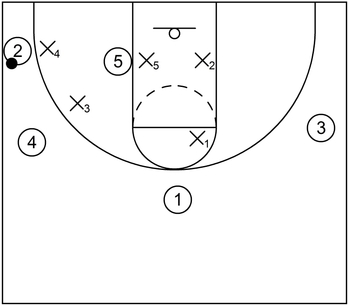
This is an example of the point zone defense if 2 cuts through to the left side corner and 5 cuts across the lane to the left side low post block.
To begin, X4 takes point while X1 fills the area near the right side high post elbow for potential defensive rebounds and to hinder a possible basket cut from 1.
X3 stands in the gap between 4 and 5 to take away middle dribble penetration and to prevent the easy post entry pass. Furthermore, X3 could be ready to take point if 4 were to receive the ball from 2.
Also, X2 is in the lane near the right side low post area, mainly to discourage a weak side basket cut by 3.
Additionally, X2 could also be prepared to execute a defensive closeout and take point in the event of a corner to wing skip pass by 2 as well.
X5 is in the center of the two pairs of other defenders and could front the low post, particularly on the baseline side if necessary.
It should also be mentioned that if the ball gets into the low post at any time, then a defender near the wing or corner could execute a double team alongside X5 to influence 5 to pass the ball back towards the perimeter areas of the court.
Using this current diagram as an example, if 4 is a below average three-point shooter, then X3 could drop back to double team with X5. Likewise, if 2 is not a good shooter, then X4 could drop back to double team alongside X5.
Example 6
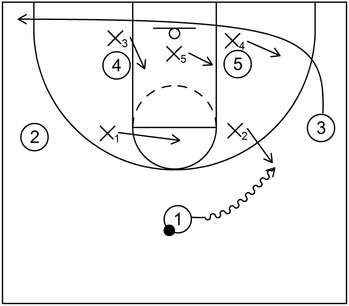
This is an example of possible defensive rotations within the point zone defense when the offense gets initiated with dribble entry action.
To start, 1 executes a dribble entry towards the right side wing which also causes 3 to cut through to the left side corner.
As that occurs, X2 could take point instead of X1 to implement defensive pressure on the ball.
Next, X1 could slide to the nail area to discourage middle dribble penetration while X4 could also slide over near the right side short corner to deter baseline dribble penetration.
Additionally, X3 could lift up into the lane near the left side low post while X5 could slide over to guard against 5 near the right side low post.
Example 7
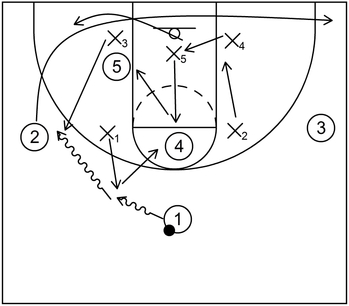
This is yet another example of defensive rotations from a dribble entry offensive set within the point zone defense.
Furthermore, the offensive team utilizes a 1-3-1 set which includes an offensive player at the top, a high post player, two wing players, and one low post player.
At the start, 1 dribbles toward the left side wing and when that occurs, X1 initially takes point near the left slot area. Also, as that happens, X5 steps up to prevent the potential pass into the high post area.
In addition to that, 2 cuts through to the right side and as 1 continues the dribble towards the left side wing, X3 takes point while X1 drops back to cover the high post area.
Moreover, X5 drops back to guard 5 on the strong side while X4 slides into the lane to protect the basket. Also, X2 drops back towards the right side low post area to hinder the possible weak side cut by 2 or 3.
It should be also noted for this case, X2 does not necessarily have to step into the lane near the weak side low post because that same low post area is empty.
Example 8
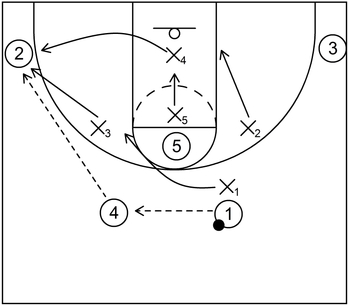
This is an example of potential defensive rotations within the point zone defense when the offensive team implements a 2-1-2 set which features a two guard front in the slots, a high post player, and two additional offensive players in the corners.
To start, 1 could immediately take point while X5 steps up to cover the high post area and X4 slides into the lane to protect the basket.
Additionally, X2 and X3 can initially fill the gaps near the high post elbows to discourage possible dribble penetration from the top to the rim.
For this case, 4 receives the ball from 1 and afterwards, 2 receives the ball from 4. When that happens, X1 could drop back to fill the space near the left side high post elbow while X4 sprints to execute a defensive closeout near the left side corner.
Furthermore, X3 could also follow X4 to set a corner trap against 2 while X2 drops back near the right side low post and X5 drops back to protect the basket.
Also, if 2 decides to throw a pass to either 4 or 5, then X1 could possibly jump into the passing lane to intercept that pass causing a turnover.
If that were to occur, then the defenders would switch into transition offense for probable fast break layups.
Example 9
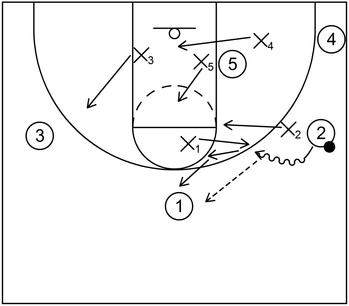
This is an example of defensive rotations within the point zone defense when the offensive team attempts middle dribble penetration from the wing.
To start, 2 tries to get dribble penetration towards the middle but when that occurs, X1 executes a defensive stunt while X2 initially follows the ball and eventually slides towards the right side high post elbow.
Afterwards, if 1 receives the ball from 2, then X1 could take point while X5 steps up below the free throw line and X4 slides into the lane to protect the basket.
X3 could also step out of the lane ready to execute a defensive closeout and take point if 3 were to receive the ball.
Example 10
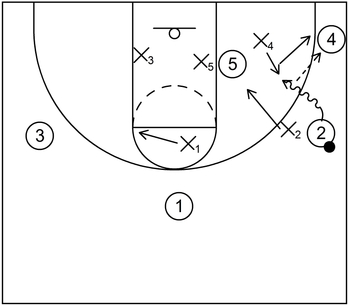
This is an example of possible defensive rotations within the point zone defense when baseline penetration occurs with a filled strong side corner.
To begin, 2 dribbles toward the baseline but X4 counters with a defensive stunt to slow down the dribble action and encourage the pass to 4.
If 2 does indeed make that pass, then X4 could take point while X2 drops back between the low post and the wing on strong side to hinder the post entry pass and to restrict middle dribble penetration as well.
X1 could slide towards the left side high post elbow, primarily for potential defensive rebounds, while X5 covers 5 and X3 watches for weak side action.